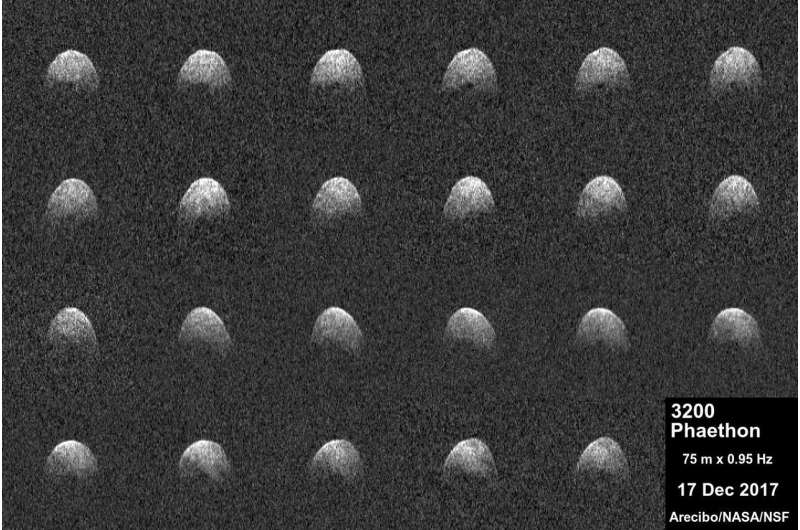These radar images of near-Earth asteroid 3200 Phaethon were generated by astronomers at the National Science Foundation's Arecibo Observatory on Dec. 17, 2017. Observations of Phaethon were conducted at Arecibo from Dec.15 through 19, 2017. At time of closest approach on Dec. 16 at 3 p.m. PST (6 p.m. EST, 11 p.m. UTC) the asteroid was about 6.4 million miles (10.3 million kilometers) away, or about 27 times the distance from Earth to the moon. The encounter is the closest the object will come to Earth until 2093. The Arecibo Planetary Radar Program is funded by NASA's Near-Earth Object Observations Program through a grant to Universities Space Research Association (USRA), from the Near-Earth Object Observations program. The Arecibo Observatory is a facility of the National Science Foundation operated under cooperative agreement by SRI International, USRA, and Universidad Metropolitana. Credit: Arecibo Observatory
Polarimetric investigation of a near-Earth asteroid Phaethon was carried out in December 2017 on its closest approach to the Earth. The study was conducted in collaboration with scientists from the Ussuriysk Astrophysical Observatory and the Astronomical Institute of the Slovak Academy of Sciences. The article has been published in the scientific journal Astronomy and Astrophysics.
Ph.D. students Ekaterina Chornaya, Anton Kochergin and graduated student Alexey Matkin, led by Evgenij Zubko, the leading researcher at the Far Eastern Federal University (FEFU) School of Natural Sciences, studied asteroid 3200 Phaeton using the polarimetric method. They measured the degree of linear polarization of the sunlight scattered from the asteroid in collaboration with their colleagues from the Ussuriysk Astrophysical Observatory and the Astronomical Institute of the Slovak Academy of Sciences.
"Using very simple and relatively inexpensive tools, we have achieved results comparable with those obtained with much bigger instruments. We studied Phaethon with a small telescope whose aperture (a primary mirror diameter) is only 22 cm. However, we obtained results of quite good quality. Surprisingly, our results appear to be more accurate than those measured by some of our colleagues with much more powerful telescopes. This is due to our non-standard solution: We decided to avoid any photometric filters except for the polarimeter," said Evgenij Zubko.
The scientist emphasized that Phaethon is of high interest for astronomers for several reasons. First, it is a near-Earth object, which makes it possible to study Phaeton using radar and other methods. Second, the asteroid has a quite elongated orbit and approaches the sun at one-sixth of an AU. For that reason, it is heated to 750-1000 Kelvin (476—726 Celsius) every 1.5 years. That's why it was named after Phaeton, the hero of the Greek myth, the son of Helios (god of the sun).
The FEFU astrophysicists have shown that the Umov effect can be applied to the study of asteroids, just as it is to studies of comets. This physical law was discovered in 1905 by the Russian physicist Nikolai Umov. The crux of it is that there is an inverse correlation between the reflectivity of the surface and the degree of linear polarization of the sunlight scattered by it. In other words, the brighter is an object, the lower polarization it produces.
Since the Umov law was originally developed to study the surfaces of relatively large objects such as the moon, it is also applicable to comets and asteroids. At the same time, the Umov law requires a very specific geometry of observation of the object that is difficult to achieve in practice for most of these small bodies. With Phaeton, it is possible due to its close encounters with the Earth.
"The point is that the favorable conditions for observation of Phaethon happen every few years, whereas the best observational circumstances occur only few times per century," says Evgenij Zubko.
"In order to accurately retrieve the Umov law in asteroids, the investigation of several asteroids is needed. It is necessary to conduct an investigation of at least one more asteroid, preferably with substantially different polarization characteristics, in order to approximately estimate the Umov effect for asteroids," the scientist said. According to the FEFU Ph.D.-student Ekaterina Chornaya, their list contains about 10 potential objects for study during the next two years and a subsequent comparison of their characteristics with Phaeton.
When Phaethon was approaching the Earth in December 2017, it was observed by at least four groups of scientists in different parts of the globe. The results of measurements of the linear polarization of the sunlight reflected by the asteroid vary considerably from one group to another. This is noteworthy. Typically, observations of asteroids carried out by different teams tend to converge to nearly the same result.
"A possible explanation is that the surface of the asteroid is highly heterogeneous: It may consist of different types of materials and/or has different microphysical properties of regolith. We can get such dispersion of the results because of the asteroid rotates fairly quickly and it can be observed from all sides during one night, " explains Evgenij Zubko, who made a preliminary report on the results of the Phaeton polarimetric study at The Ninth Moscow solar system Symposium 9M-S3.
Provided by Far Eastern Federal University
























